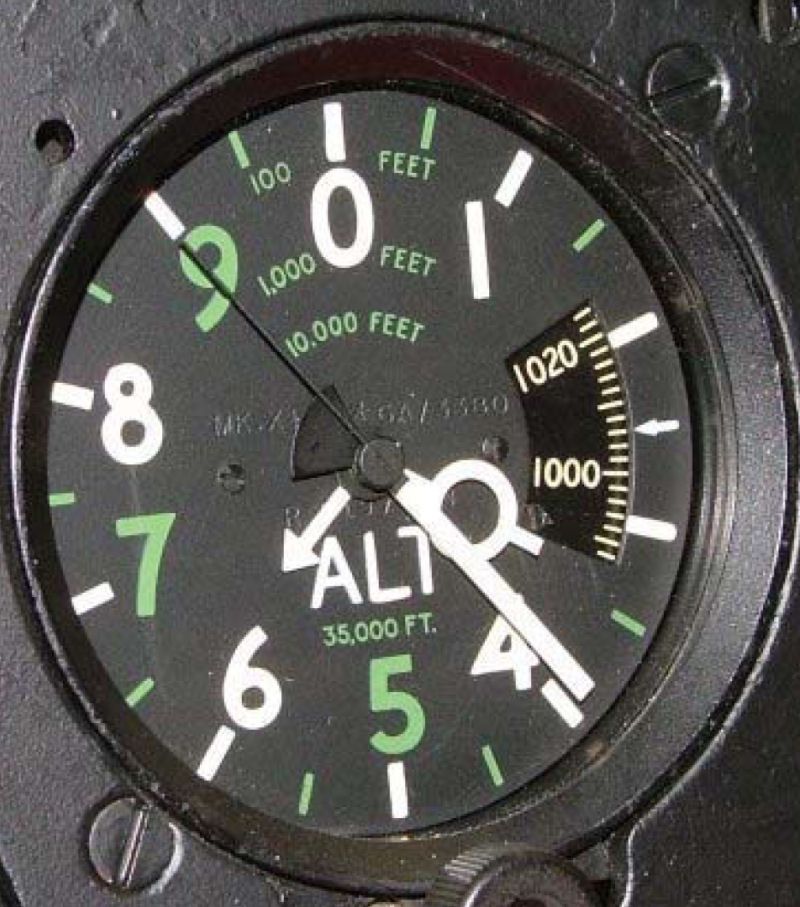Vampire rips up runway...
such as the precession of the artificial horizon during take off (acceleration)
Join Date: Jul 2008
Location: Australia OZ
Age: 75
Posts: 2,577
Likes: 0
Received 52 Likes
on
45 Posts
To my mind the 'rain' if any was the least of our 'flying AEO' (Air Engineer Officer at that time) worries. Several of us from VC-724 were on a survival exercise west of the airfield (being buzzed by a Venom for some reason) and drenched by thunderstorms. We got back to the squadron to the news of the Vampire crash with severe injury to the pilot a day or so later. He really was on his 'last flight before retiring' (a MAXbus - when all available aircraft go pound some ships). He was unauthorised for instrument flight so he had to return to the field quickly, before the others airborne, in an attempt to beat the approaching thunderstorm from the west.
Sadly he was probably caught in what we know today as a microburst from the storm just west of the field. Unable to land he had to go around into the storm itself but likely from what I was told the aircraft was forced into the trees just west of the field RW26 by the severe thunderstorm downdraught. He attempted ejection just at that moment but the seat went into the front windscreen during the crash - he was lucky to survive. Sadly he was then confined to a wheelchair to become a successful lawyer in Canberra. He died a few years ago now.
JPG from VC-724 line book pages recording the accident on 15 May 1969. The right hand seat unoccupied has fired when aircraft hit trees/ground. The left seat with pilot has impacted the windscreen as shown because he initiated ejection earlier. The second JPG shows little if any crash trail through trees as the aircraft was going down vertically due to severe thunderstorm effect at probably a very low airspeed caused by severe local conditions. By accounts at the time the thunderstorm was a MONSTER!
Third JPG shows the relative intactness of the Vampire with the right hand seat parachute draped over it.
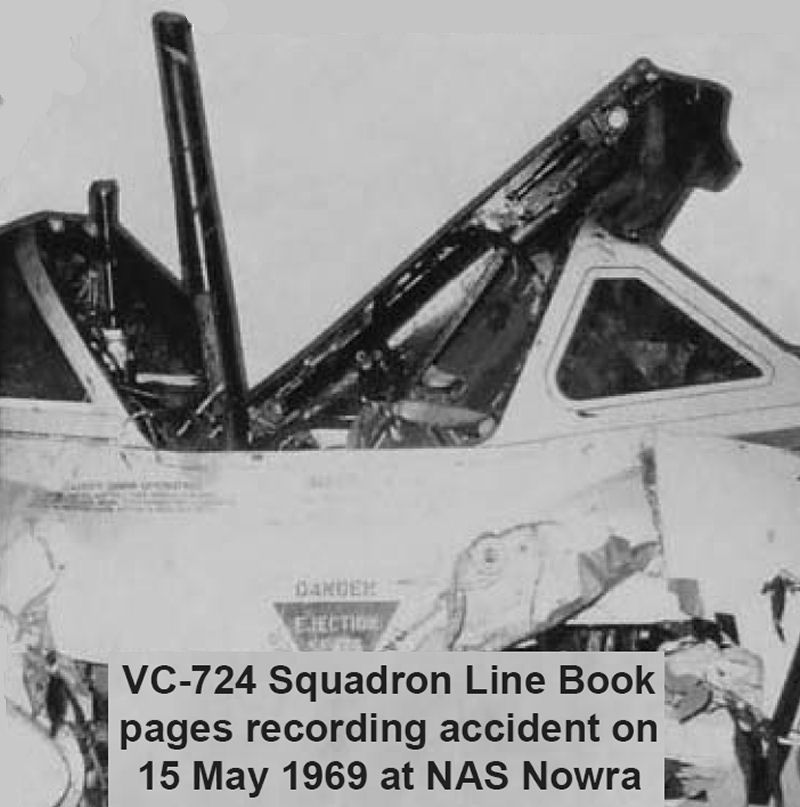
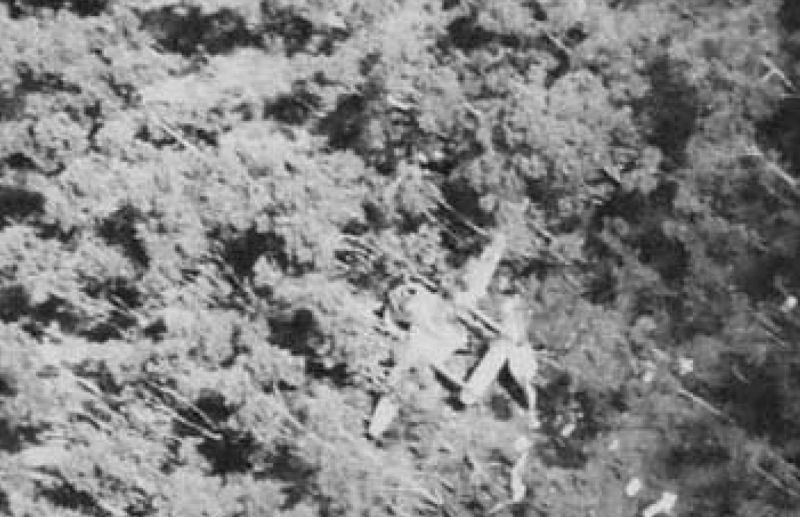
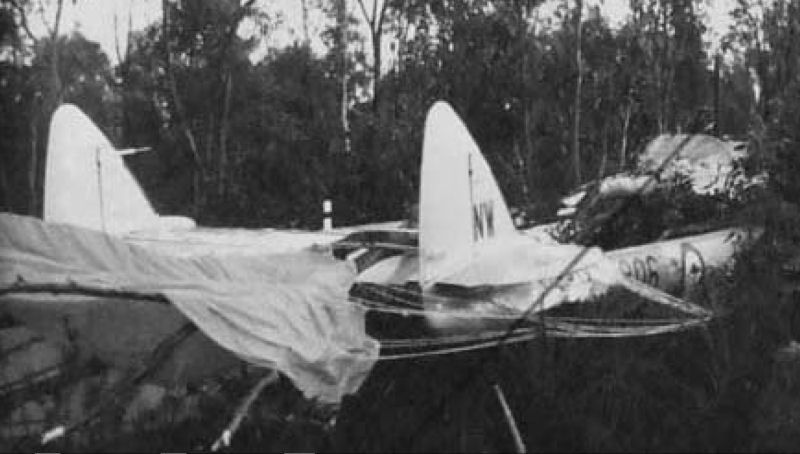
Sadly he was probably caught in what we know today as a microburst from the storm just west of the field. Unable to land he had to go around into the storm itself but likely from what I was told the aircraft was forced into the trees just west of the field RW26 by the severe thunderstorm downdraught. He attempted ejection just at that moment but the seat went into the front windscreen during the crash - he was lucky to survive. Sadly he was then confined to a wheelchair to become a successful lawyer in Canberra. He died a few years ago now.
JPG from VC-724 line book pages recording the accident on 15 May 1969. The right hand seat unoccupied has fired when aircraft hit trees/ground. The left seat with pilot has impacted the windscreen as shown because he initiated ejection earlier. The second JPG shows little if any crash trail through trees as the aircraft was going down vertically due to severe thunderstorm effect at probably a very low airspeed caused by severe local conditions. By accounts at the time the thunderstorm was a MONSTER!
Third JPG shows the relative intactness of the Vampire with the right hand seat parachute draped over it.



Last edited by SpazSinbad; 2nd May 2017 at 17:11. Reason: spellin & +grfx
Join Date: Mar 2010
Location: Often in Jersey, but mainly in the past.
Age: 79
Posts: 7,809
Received 135 Likes
on
63 Posts
S. h. 1. T. 

Join Date: Jul 2008
Location: Australia OZ
Age: 75
Posts: 2,577
Likes: 0
Received 52 Likes
on
45 Posts
The seriously injured Vampire pilot was not a neophyte. Formerly he had been a BANSHEE/Tracker pilot in the RCN off HMCS Bonaventure so he was not going to be fooled by any artificial horizon precession. However he did not fly all that much so he did not have an instrument rating - the reason he ended up in such dire circumstances. It really was his last flight before retirement. 3 page PDF attached is about this crash - thunderstorm microburst info not included.
Last edited by SpazSinbad; 2nd May 2017 at 18:53. Reason: add PDF
Join Date: Jul 2008
Location: Australia OZ
Age: 75
Posts: 2,577
Likes: 0
Received 52 Likes
on
45 Posts
FWIW yonks ago I wrote this text for ADF-serials.com and provided them with the map as seen in this two page PDF attached. https://www.faaaa.asn.au/spazsinbad-a4g/
Hammond initials? Dunno. Two dates are given but I do not know correct date - 20 or 21 Jan 1966. Probably the discrepancy relates to night flying which could go after midnight at Pearce during these years. My first night solo was after midnight then next day bright & early back to bidness. I think my 'B' flight had ground school in morning then flying in arvo.

"“RAAF Series 2 - ADF Aircraft Serial Numbers | A78, A79 and N6. De Havilland DH-100/DH-115 RAAF / RAN Vampire | A79-653 4175 T.35 According to aircraft status card aircraft "crashed, exploded and burned whilst on a training flight" 21/01/66 1AFTS Pearce WA.” : ADF-Serials Vampire
“Briefly the story is that due to the known precesssion of the Vampire Attitude Indicator during the Takeoff Run, it was known to allow for that by — after liftoff at night — to fly with about a five degree to port attitude, with nose slightly higher than usual for climb. This overrode the precession which — if followed — would cause the aircraft to fly as Hammond did — to the right and down. All Vampire students (pretending IMC/night) were shown this effect by flying towards the hills (with instructor) during the day after an instrument T/O on RW36. The Vampire aircraft all pointed towards to the same black spot in the hills to the east of airfield (if following AI).”
“Briefly the story is that due to the known precesssion of the Vampire Attitude Indicator during the Takeoff Run, it was known to allow for that by — after liftoff at night — to fly with about a five degree to port attitude, with nose slightly higher than usual for climb. This overrode the precession which — if followed — would cause the aircraft to fly as Hammond did — to the right and down. All Vampire students (pretending IMC/night) were shown this effect by flying towards the hills (with instructor) during the day after an instrument T/O on RW36. The Vampire aircraft all pointed towards to the same black spot in the hills to the east of airfield (if following AI).”

Sadly he was probably caught in what we know today as a microburst from the storm
Join Date: Jul 2008
Location: Australia OZ
Age: 75
Posts: 2,577
Likes: 0
Received 52 Likes
on
45 Posts
Without being at the airfield at the time as explained I cannot say more except speaking to squadron aircrew either in the air or left behind that day or ATC the storm was 'something else'. The survival group were not that far from the airfield but in the 'tiger country' out west and we had did experience the local storm phenomena, I recall some big thunderies during our days out there.
However 'microburst' phenomena was unknown at that time. Google that term. There are a few pages saved over the years but I've not kept up with latest microburst research. I ain't flyin' nowhere these days - too dangerous. :-) So it is likely the microburst ahead of the storm caused the pilot to miss landing the Vampire to then overshoot into the storm. I cannot say I have deliberately flown into a storm especially near the ground. The Vampire did not have a lot of get up and go at low speed accelerating to climb speed so I'll gather the Vampire was still at slow airspeed struggling in the storm downdraught. One can see it must have come down almost vertically due to lack of tree damage to the rear of the crash site. I have never seen a crash report. Perhaps the NAA National Australian Archive will have something? I find that website difficult to use.
Remember the accident report looks for reasons and they did not know about microbursts at that time; nor likely the severity of the storm downdraught; whilst other factors cited by you may have contributed. I can only say what has been said already. What the pilot said afterward is unknown to me however I gather there will be the accident transcript.
Jet pilots in that era did not deliberately take off into an approaching thunderstorm, so experience of those unique conditions would be minimal. Also recall the rising ground west of RW 26 did not help the low climb performance, even though the aircraft was overshooting. I did not go out to the crash site nor recall seeing it from the air (I guess the wreck was removed quickly). Do you recall how far Vampire was from threshold RW 08?
NAVAIR 00-80T-112 NATOPS INSTRUMENT FLIGHT MANUAL 15 NOVEMBER 2006

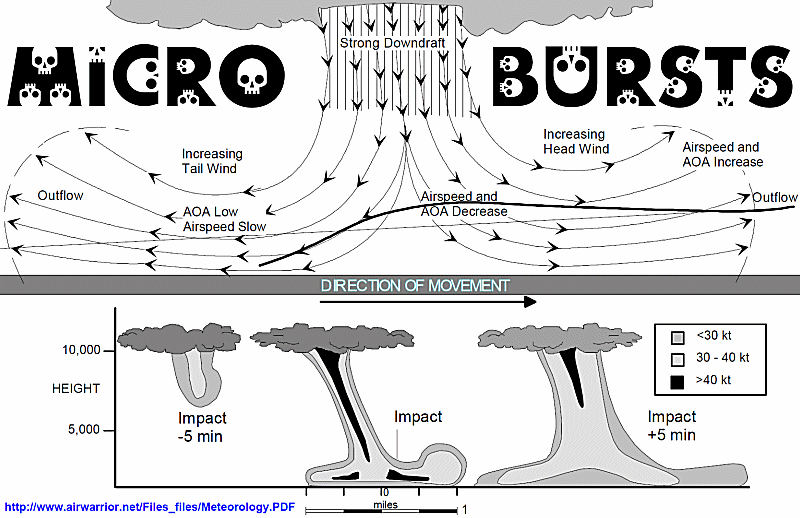
However 'microburst' phenomena was unknown at that time. Google that term. There are a few pages saved over the years but I've not kept up with latest microburst research. I ain't flyin' nowhere these days - too dangerous. :-) So it is likely the microburst ahead of the storm caused the pilot to miss landing the Vampire to then overshoot into the storm. I cannot say I have deliberately flown into a storm especially near the ground. The Vampire did not have a lot of get up and go at low speed accelerating to climb speed so I'll gather the Vampire was still at slow airspeed struggling in the storm downdraught. One can see it must have come down almost vertically due to lack of tree damage to the rear of the crash site. I have never seen a crash report. Perhaps the NAA National Australian Archive will have something? I find that website difficult to use.
Remember the accident report looks for reasons and they did not know about microbursts at that time; nor likely the severity of the storm downdraught; whilst other factors cited by you may have contributed. I can only say what has been said already. What the pilot said afterward is unknown to me however I gather there will be the accident transcript.
Jet pilots in that era did not deliberately take off into an approaching thunderstorm, so experience of those unique conditions would be minimal. Also recall the rising ground west of RW 26 did not help the low climb performance, even though the aircraft was overshooting. I did not go out to the crash site nor recall seeing it from the air (I guess the wreck was removed quickly). Do you recall how far Vampire was from threshold RW 08?
NAVAIR 00-80T-112 NATOPS INSTRUMENT FLIGHT MANUAL 15 NOVEMBER 2006
"Microbursts pose a serious threat to aircraft, especially those conducting the arrival or departure phase of flight, or operating at low altitudes adjacent to areas of convecting activity. The rapid onset of dangerous downflow and tailwind shear must be met with quick responsive action by the pilot. The only safe way to deal with a microburst is to avoid flying in areas where microbursts may develop. Specifically, pilots should delay takeoffs, approaches, and/or landings when operating near convective activity until the convective activity has moved safely away from the flightpath." http://info.publicintelligence.net/U...ightManual.pdf


Last edited by SpazSinbad; 3rd May 2017 at 02:27. Reason: add text & grfx
Join Date: Jul 2008
Location: Australia OZ
Age: 75
Posts: 2,577
Likes: 0
Received 52 Likes
on
45 Posts
Eight pages of MicroBurst and ThunderyBumpery Goodness attached (out of date a bit though). NOTICE the time/movement/burst effect in the graphic immediately above. Here one second and gone the next - with the wind & rain.
By the by I had flown with the mishap pilot in the right seat of a Venom 'under test' after specific maintenance. He knew how to fly the aircraft; but not a lot of hours in Venom I guess; and again I guess he had hours in the RCN in Vampires.
It always puzzled me why he was not able to land the Vampire that fateful day. Having 'discovered' the 'microburst effect' years later I had an understanding of the LIKELY difficulties he faced.
By the by I had flown with the mishap pilot in the right seat of a Venom 'under test' after specific maintenance. He knew how to fly the aircraft; but not a lot of hours in Venom I guess; and again I guess he had hours in the RCN in Vampires.
It always puzzled me why he was not able to land the Vampire that fateful day. Having 'discovered' the 'microburst effect' years later I had an understanding of the LIKELY difficulties he faced.
Last edited by SpazSinbad; 3rd May 2017 at 03:42. Reason: add txt
The phenomenon of artificial horizon acceleration errors was well-known by 1966 and it surprises me that Australian Vampires hadn't been retrofitted with modified versions by then. What with that and the 3-pointer altimeter, IF must have been such fun in those days...
Quite how anyone accepted an aircraft into service with a cabin temperature/pressure selector the same shape as the elevator trim wheel, undercarriage and flap levers on the same (virtually hidden) quadrant box, dive brake lever next to the HP cock and the LP cock under the throttle, is beyond me. An ergonomic nightmare! Hunter T7 and Jet Provost were a lot safer in that regard.
de Havilland might have made pretty-looking aeroplanes, but cockpit ergonomics don't seem to have been their strongest suit.

Quite how anyone accepted an aircraft into service with a cabin temperature/pressure selector the same shape as the elevator trim wheel, undercarriage and flap levers on the same (virtually hidden) quadrant box, dive brake lever next to the HP cock and the LP cock under the throttle, is beyond me. An ergonomic nightmare! Hunter T7 and Jet Provost were a lot safer in that regard.
de Havilland might have made pretty-looking aeroplanes, but cockpit ergonomics don't seem to have been their strongest suit.
Join Date: Jul 2008
Location: Australia OZ
Age: 75
Posts: 2,577
Likes: 0
Received 52 Likes
on
45 Posts
I'm pleased you mention the three handed altimeter 'BEagle' the other things are self-evident. Photos of Spitfire front instrument panels look very similar to early VAMPIRE single seaters and that flowed onto the many variations of layouts in the dual seat Vamp family. Who could put the AH in front of the pilot hand on stick? Only deHav. It has been some 46 years since I've seen a working Vampire cockpit so imagining how the 3 needle altimeter worked just from photos these days can be a stretch. I'll post a graphic and ask the good readers 'what is it showing' and will appreciate any replies.
Meanwhile back at NAS Nowra we likely lost a CMDR Air to the dastardly altimeter one night carrying out an instrument high ADF approach back to the airfield. The specifics used those days are no longer published or needed but in short the aircraft would fly overhead at 20,000 feet to descend outbound to the east (over coast then water) to turn inbound at 10,000 feet to the airfield and usually picked up by GCA because safe height was quite high with just an ADF beacon. Anyway it was thought the CMDR misread the altimeter by 10K to then crash into the dark ocean on probably a dark night.
What was the most fun was micro-managing the engine RPM on that thread the needle gauge. Of course there was an RPM band at the high end that could kill the engine if youse stayed there (despite horrendous noises apparently) too long. It was a fun aircraft to fly though - no spinning allowed and watch that nosewheel during a touch and go with the throttle advancing without undue noises (rumble from overfuelling).
From the RAAF Mk.35 & 35A Vampire Flight Manual:
Thank goodness our early examples gained an ejection seat eventually - so there was some upgrading going on. However a fouled lanyard from the seat pan in the flight controls caused a fatal crash just after takeoff (again RW26) pilot could NOT untangle controls being on the radio asking for help as it went in.

Meanwhile back at NAS Nowra we likely lost a CMDR Air to the dastardly altimeter one night carrying out an instrument high ADF approach back to the airfield. The specifics used those days are no longer published or needed but in short the aircraft would fly overhead at 20,000 feet to descend outbound to the east (over coast then water) to turn inbound at 10,000 feet to the airfield and usually picked up by GCA because safe height was quite high with just an ADF beacon. Anyway it was thought the CMDR misread the altimeter by 10K to then crash into the dark ocean on probably a dark night.
What was the most fun was micro-managing the engine RPM on that thread the needle gauge. Of course there was an RPM band at the high end that could kill the engine if youse stayed there (despite horrendous noises apparently) too long. It was a fun aircraft to fly though - no spinning allowed and watch that nosewheel during a touch and go with the throttle advancing without undue noises (rumble from overfuelling).

From the RAAF Mk.35 & 35A Vampire Flight Manual:
"Note 1: To avoid resonance, vibration and subsequent impeller failure, it is imperative that engine operation between 10,350 and 10,650 be avoided at all times, except when accelerating or decelerating through this sector.
WARNING
It cannot be emphasised too strongly that failure to adhere to this limitation could result in impellor failure in a very short time. [Then it goes on about the other resonant ranges that have less immediate dire consequences - oh joy oh frabjous day]
WARNING
It cannot be emphasised too strongly that failure to adhere to this limitation could result in impellor failure in a very short time. [Then it goes on about the other resonant ranges that have less immediate dire consequences - oh joy oh frabjous day]

Last edited by SpazSinbad; 3rd May 2017 at 07:23. Reason: add txt & grfx
"Mildly" Eccentric Stardriver
I'm following this thread with interest, especially SpazSinbad's contributions. I was at RAAF Pearce for six years, as a teenager (11 to 17) between late '57 and early '64. My father was based there, in a ground role. I'd always had a leaning towards wanting to fly, but I think the constant presence of Vampires, plus of course all the visitors, from Vulcans to Globemasters, was what finally settled it. Forty years of flying later, than you Vampires.
Join Date: Jul 2008
Location: Australia OZ
Age: 75
Posts: 2,577
Likes: 0
Received 52 Likes
on
45 Posts
FARRKK!!! as we used to say. :-) One of the best early days at Pearce (did not use RAAF in those days I think but they do now so excuse) and there were lots because for one we graduated to wings standard (then the NAVY provisional wings had to be authenticated with a deck landing - which for me took ages). But hey - made it. Anyhoo back to the day the VULCANS took off one early winter morning (we were there from mid 1968 to the end of the year - see the 50th thread for more details). Sadly we were a long way away on the flight line at the other end of the airfield as these monsters trundled off with a great roar belching black smoke. I've since lost my pathetic wide angle photos with them as tiny dots highlighted by the smoke. IF you follow the link to RAN FAAAA page you will find a PDF or two just about Vampires - these PDFs have the info you see here.
I was 19 years old (as most cadets were approx.) during the flying training year with the RAAF turning 20 just before graduation in Dec 1968.
I was 19 years old (as most cadets were approx.) during the flying training year with the RAAF turning 20 just before graduation in Dec 1968.
Join Date: Jul 2008
Location: Australia OZ
Age: 75
Posts: 2,577
Likes: 0
Received 52 Likes
on
45 Posts
With dual north south runways RAAF Pearce today looks to be much different, especially with the Macchi era sunshades on flight line. The long taxi to threshold 36 from the top north eastern side was a chore for beginners using the brakes too much - woe betide any stopping before reaching the concrete at the end. Just before GinGin became operational the circuit was chaotic with Vamps & Macchis mixing it up with cries of 'CHICKENMAN' in the flying areas. :-) Photo taken in 2011 new runway is west of the old runway I guess? The east west runway was never used due to the line of low hills to the east of the field. Probably on a really windy sou'wester day an instructor may have taken off on it but no landings. GinGin was for Macchis only and then the Vamps were gone by about mid 1969. The last Vamp course was No.69 with No.68 being the first Macchi course whilst instructors got up to speed on them earlier.
http://i842.photobucket.com/albums/z...roger/jlc2.jpg
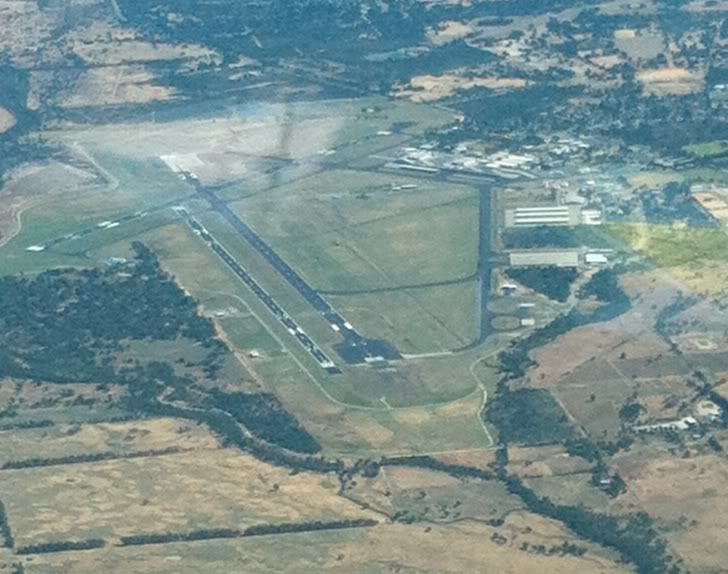
http://i842.photobucket.com/albums/z...roger/jlc2.jpg

Join Date: Mar 2010
Location: Often in Jersey, but mainly in the past.
Age: 79
Posts: 7,809
Received 135 Likes
on
63 Posts
SpazSinbad ... the construction of a shorter and narrower 36L at Pearce is interesting me.
Why did they do that??
Why did they do that??
Join Date: Jul 2008
Location: Australia OZ
Age: 75
Posts: 2,577
Likes: 0
Received 52 Likes
on
45 Posts
'MPN11' one would have to ask the RAAF. However the base has expanded a lot since 1968 with various training squadrons including Singaporean Air Force. I have no idea how it all works now because I've been out since mid 1975 and I ain't crab.  Google Search History RAAF Base Pearce WA Australia has a lot to offer - onesuch: Extra runway for all these aircraft....
Google Search History RAAF Base Pearce WA Australia has a lot to offer - onesuch: Extra runway for all these aircraft....
 Google Search History RAAF Base Pearce WA Australia has a lot to offer - onesuch: Extra runway for all these aircraft....
Google Search History RAAF Base Pearce WA Australia has a lot to offer - onesuch: Extra runway for all these aircraft....
RAAF Base Pearce
"Royal Australian Air Force's Base Pearce is 35kms north of Perth. It is primarily home to No 2 Flying Training School and No 79 Squadron. The Republic of Singapore's No 130 Squadron is also based at Pearce.
No 2 Flying Training School
PC-9/A trainer aircraft [would be happy with the new runway with jets on original rw]
No 79 Squadron
Hawk 127 fighter trainer aircraft
No 453 Squadron Pearce Flight air traffic control
No 25 (City of Perth) Squadron airbase operations
No 3 Security Forces Squadron Detachment Pearce
No 1 Expeditionary Health Squadron Detachment Pearce
Republic of Singapore Air Force (No 130 Squadron) trainer aircraft"
http://www.airforce.gov.au/Bases/Wes...GnJ2np16BAjbht
"Royal Australian Air Force's Base Pearce is 35kms north of Perth. It is primarily home to No 2 Flying Training School and No 79 Squadron. The Republic of Singapore's No 130 Squadron is also based at Pearce.
No 2 Flying Training School
PC-9/A trainer aircraft [would be happy with the new runway with jets on original rw]
No 79 Squadron
Hawk 127 fighter trainer aircraft
No 453 Squadron Pearce Flight air traffic control
No 25 (City of Perth) Squadron airbase operations
No 3 Security Forces Squadron Detachment Pearce
No 1 Expeditionary Health Squadron Detachment Pearce
Republic of Singapore Air Force (No 130 Squadron) trainer aircraft"
http://www.airforce.gov.au/Bases/Wes...GnJ2np16BAjbht
Last edited by SpazSinbad; 3rd May 2017 at 12:11. Reason: info Pearce Sqdns
"Mildly" Eccentric Stardriver
RAAF Pearce. The threshold of 23 used to be closer to the Great Northern Highway, and there was a storm drain where we keen lads could watch the aircraft landing over the top of us. The taxiway leading to 36 had the bush coming very close to it, and we could sit there and watch the aircraft going past, until a Landrover (crash one I presume) came and told us to b**ger off, at which point we'd move a few hundred yards down. This was of course early sixties, and a lot has changed since then.
Join Date: Mar 2010
Location: Often in Jersey, but mainly in the past.
Age: 79
Posts: 7,809
Received 135 Likes
on
63 Posts
So RSAF trainers use 36L, and the RAAF use 36R? still too close for parallel runway operations, but I guess it could help keep things moving. I remember the complexities at Tengah, mixing fast-jets various with the first of the RSAF Cessna 172s and 20 Sqn's Single Pioneers all trying to occupy the same strip of tarmac.
Interesting notes about RAAF Vampire T11 (Australian variant of) engine ops.
The Goblin in the RAF T 11 had an avoid rpm zone of 8150 to 8650 and at 10,500 with a max of 10650.
Different engine in Austalian Vampires?
The Goblin in the RAF T 11 had an avoid rpm zone of 8150 to 8650 and at 10,500 with a max of 10650.
Different engine in Austalian Vampires?




